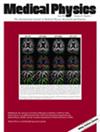Characterization and inter-scanner reproducibility of geometric distortion on a small footprint, high-performance, head-specific 0.5 T scanner
Abstract
Background
Magnetic resonance imaging (MRI) offers superior soft tissue contrast and essential imaging capabilities for modern medicine. MRI is increasingly being used in applications that require a high degree of spatial fidelity; however, distortions are a well-known limitation of the modality. The mid-field (0.3 T ≤ B0 < 1 T) has advantages in this respect due to being less susceptible to patient-induced distortions.
Purpose
The purpose of this work was to characterize the geometric fidelity of a short-bore, head-specific, 0.5T MRI system.
Methods
Assessment of spatial fidelity was performed using a 3D gradient recalled echo (GRE) acquisition on a commercial distortion phantom using the validated distortion analysis software provided. B0-induced distortions were measured using a 3D field map. Inter-scanner reproducibility was assessed across four distinct systems of identical make and model, while intra-scanner repeatability was assessed at one site over six repeat measurements.
Results
Inter-scanner reproducibility measured an average 95th percentile distortion over 100 and 180 mm DSV of 0.15 ± 0.03 and 0.33 ± 0.05 mm. Average 95th percentile distortions due to B0 field inhomogeneities over 100 and 180 mm DSV were 0.02 ± 0.01 and 0.07 ± 0.02 mm. Intra-scanner repeatability measured the uncertainty in distortion values to be 0.020 ± 0.005 mm.
Conclusion
The total residual distortions measured in this phantom study were less than half the recommended value required for radiosurgery and significantly better than data published from other MR systems. This demonstrates that in addition to the compact footprint of the Synaptive 0.5T scanner, it exceeds current standards for geometric accuracy.


 求助内容:
求助内容: 应助结果提醒方式:
应助结果提醒方式:


